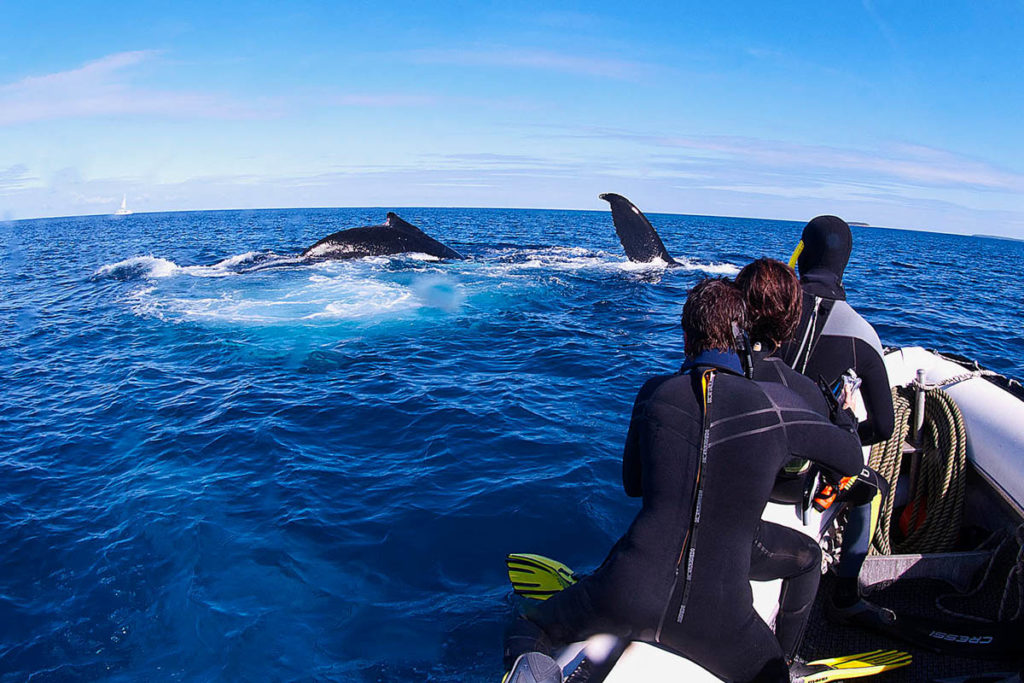Having arrived in Tonga the evening before, in mid-afternoon we – a mixed group of divers and whale-lovers from around the globe – begin the 120 km, nine-hour run from the capital, Nuku’alofa, to the Ha’apai Islands Group, where we’ll spend the next nine days searching for and interacting with Humpback Whales. Our ship, the Nai’a, is a 37 meter-long, deep-hulled steel vessel, which quickly shows itself to be an extremely stable craft, handling even wind-blown, open-ocean seas with scarcely any detectable roll or heave. Nai’a, based in Fiji for most of each year, has carried out voyages to Tonga for whale season since 1996 and has considerable experience and expertise with in-water whale encounters. En route, we learn about Humpbacks and what we could expect throughout our voyage (and, as I was pleased to discover, even my most grand imaginings were to quickly prove paltry, indeed).
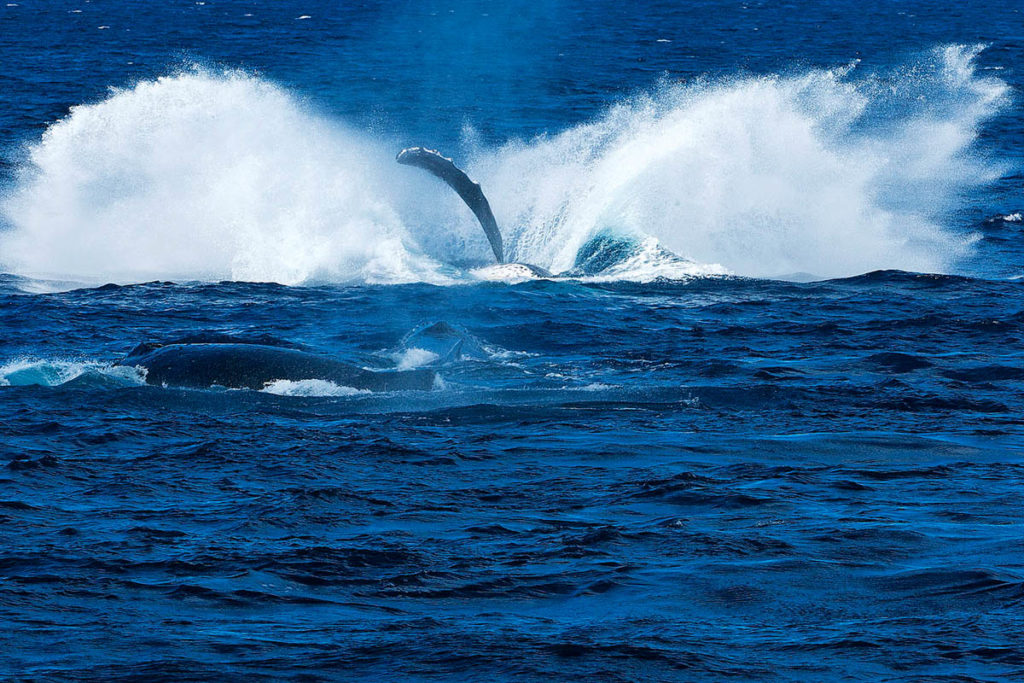
Tonga’s Humpback tribe consists of more than 2300 whales. They live and feed – chiefly on swarms of krill – in Antarctica, swimming some 5000 km to Tonga each year to spend July – October giving birth and mating. After they leave Antarctica, the whales do not feed for the approximately five months until their return (calves are the great exception, enjoying some 100 gallons of their mothers’ thick, fatty milk a day until they mature enough to feed themselves). Only after the newborn calves, some five meters long and weighing one to two tons at birth, are strong enough for the arduous return trip do they all head back to Antarctica.
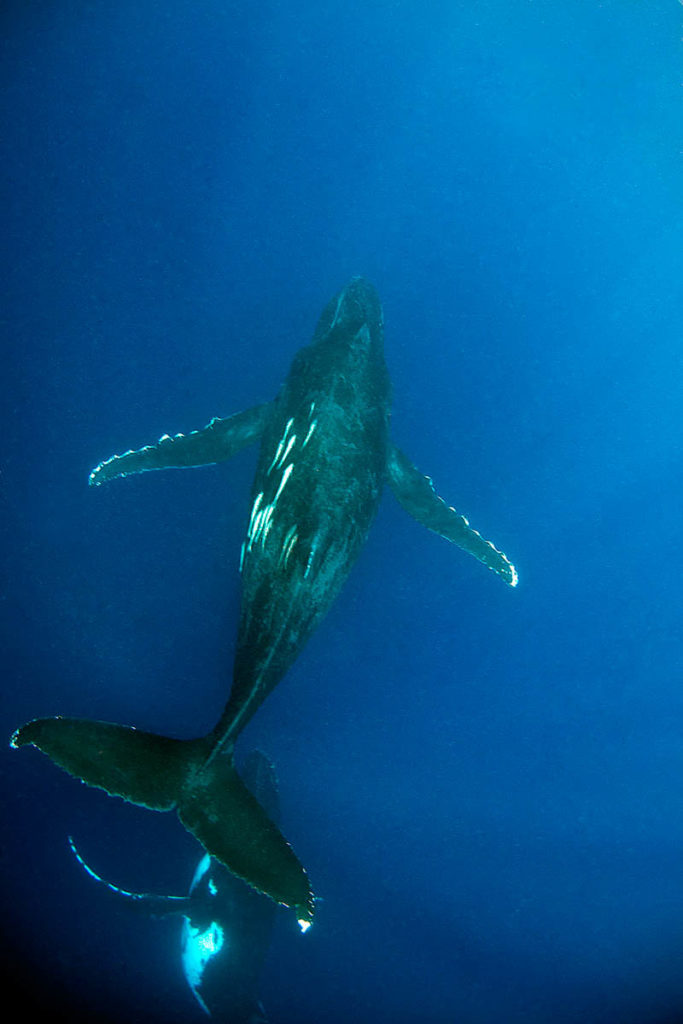
Once in the Ha’apai Group, our routine would be simple – beginning each morning just after day-break, the ship would slowly cruise, looking for whales. When whales showed interest in the ship or a willingness to be closely approached, we would quickly board our two inflatable skiffs and move in carefully for in-water (on snorkel) encounters. Nai’a’s experienced Fijian and Tongan crew proved incredibly adept at spotting and approaching whales; our two divemasters were equally expert in leading close, in-water encounters. Each late afternoon, if no encounters were occurring, a reef scuba dive and a night dive would be provided (though, several afternoons, whale encounters ran on into sunset – few people ever decided to stop for a dive, although it was always offered).
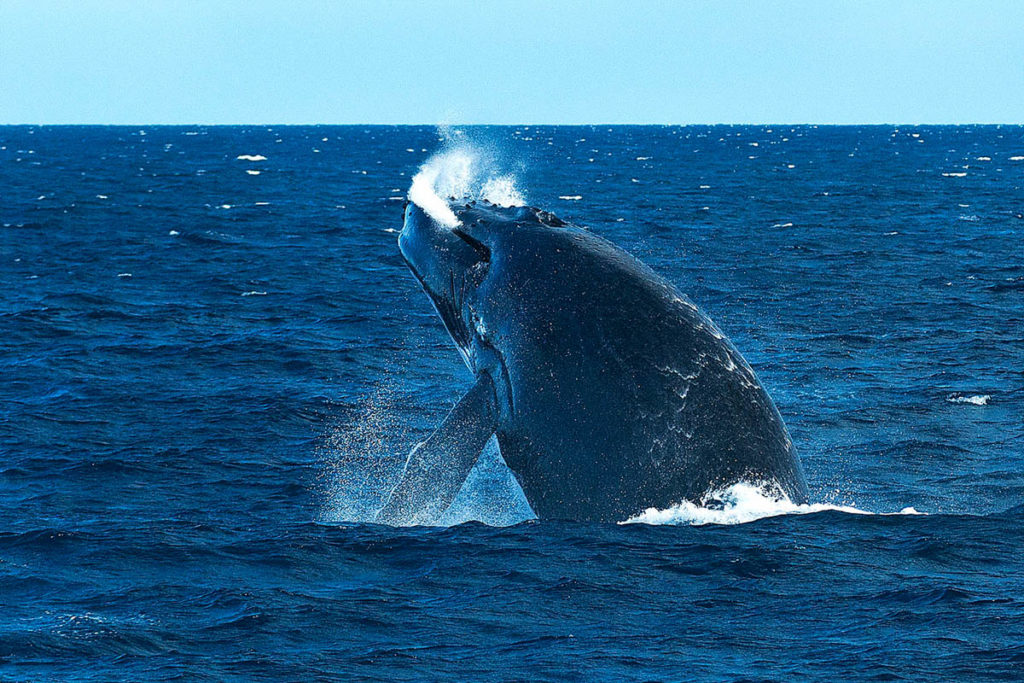
On our first morning, after many far-off sightings (a massive Humpback breaching – leaping out of the water – and its huge splash can be spotted from surprising distances), we find our first whale group that allows us to approach. The whales seem unconcerned with the ship, and we follow closely. They are rowdy and aggressive, apparently three males competing for a female, in what’s known as a ‘heat-run’. The males display, slapping their tails on the water, breaching, slapping their five meter-long pectoral fins and jostling each other, trying to be the nearest to the female. Visually, it’s incredible, watching these 15 meter-long, 40 ton behemoths exhibit such wild behavior. When it’s clear they show no intention of avoiding us, we quickly board the skiffs for our first in-water encounter.
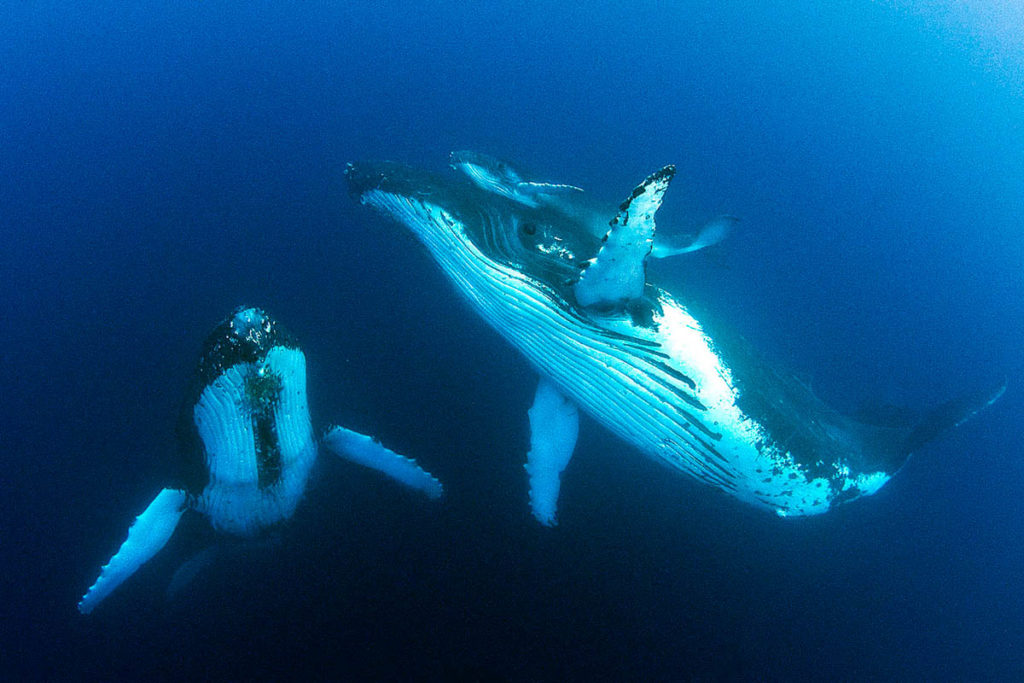
Since they are constantly moving, the encounters will be ‘fly-bys’, moving in close and our dropping in, into their path. Up close, it’s high-adrenaline, with their wild behaviors occurring at times just meters away from us, huge tails raised above us in our low skiffs, with spray and their exhalations splashing down upon us. When the time seems right, we slip in, at first seeing nothing but deep, blue water. Then, there is a hint of motion and a sudden flash of white, pectoral fins as two huge whales swoop by just below us. In a moment they are gone, leaving us wide-eyed and whooping with excitement at our first in-water experience with Humpbacks.
After several such fly-bys, as their rowdiness increases, our divemasters make the call – the whales have become too rough and unpredictable; although they show no malice towards us, in their wildness an accidental brush by one of these huge animals would be disastrous. We return to Nai’a to search for calmer whales.
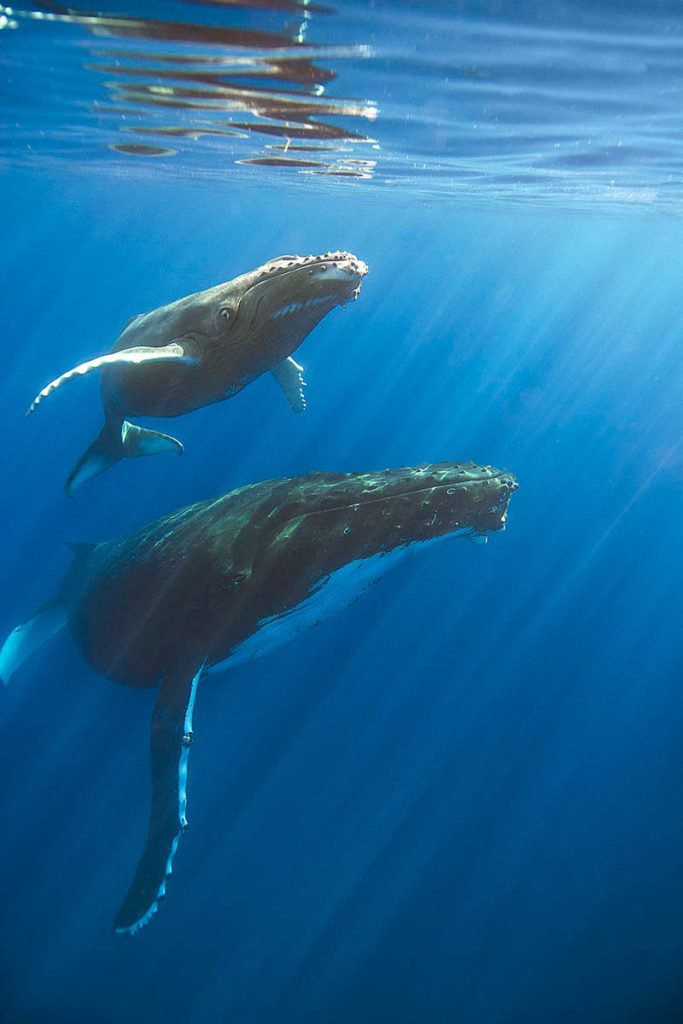
In late-afternoon, we spot what we quickly learn can provide the ideal situation for in-water encounters – a mother and calf. When a mother becomes comfortable with the ship and the skiffs, magic can happen. The calves tend to be curious and often unafraid of approaching people in the water, and the mothers let them explore their growing independence. On this occasion, it’s even more interesting – there is also an escort, another adult whale, which can be a male or female that serves as a protector.
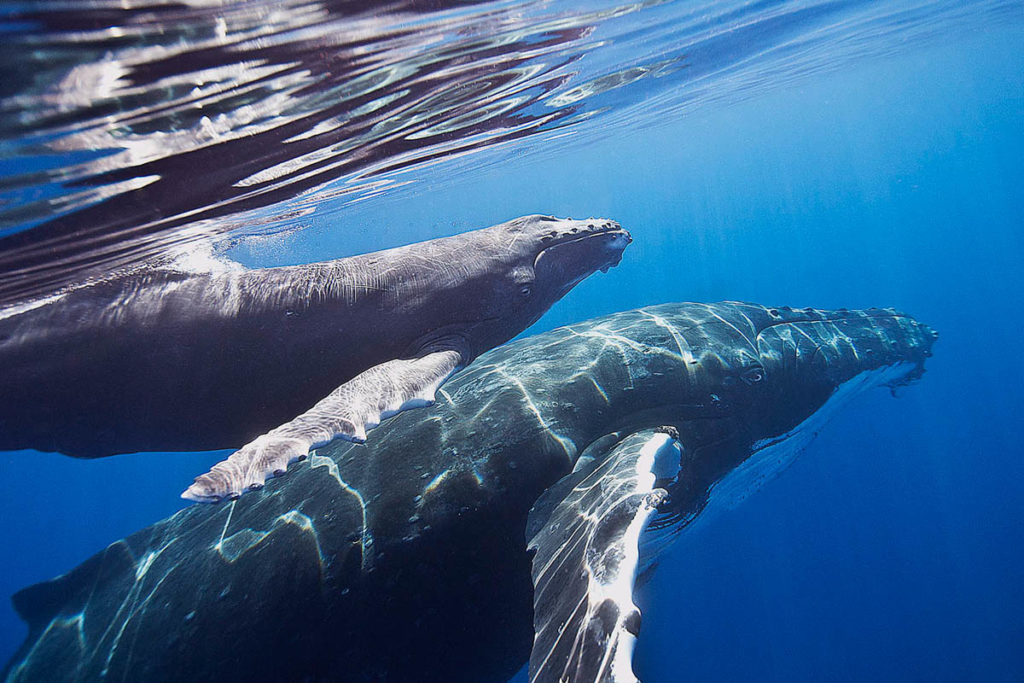
During a more than two-hour series of encounters, at one point while the escort and mother hang suspended vertically at about 15 meters of depth, the calf’s curiosity overcomes its caution, and it swims to us, approaching to within a few feet. Despite being so young, it’s about 5 meters long, weighing some 2000 lbs, its baby’s skin pinkish-gray, its eyes bright and round in seeming wonder as it looks at us. As for me, I can barely fathom the incredible thrill I feel at being so close to – and so intently regarded by – these immense, beautiful creatures.
After a nearly two-hour encounter, with building, late afternoon clouds, the sun’s rays slanting through darkening water, I’m free-diving down to the two adult whales, making image after image. The calf joins them, and then we all slowly move upward, together. As we reach the surface, mother and calf give me a final, goodbye look-over from only meters away, and they slowly disappear into the gathering gloom…
So goes day one.
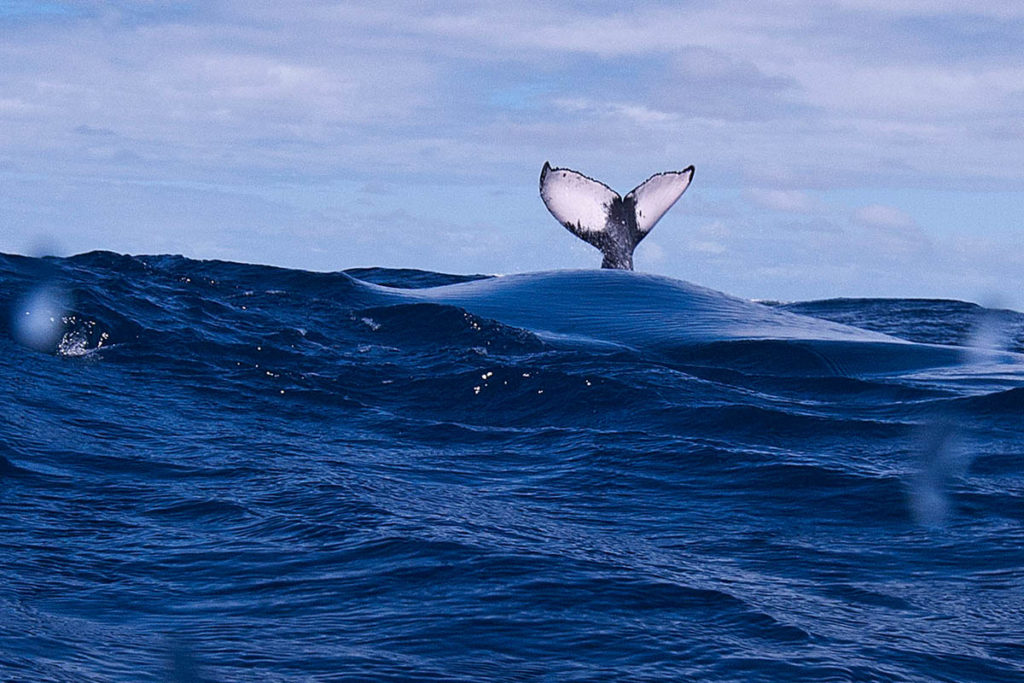
For the next eight days, while each is different, there is really no let-down. On the second day, four, rowdy juvenile males (they tend to associate in small packs), take an interest in the ship, and make it the center of their playground for more than hour. We jump in off the stern and are exhilarated by their play and repeated passes. They come in close, blowing streams of bubbles from their blow-holes, cavorting around us. At one incredible moment, they all four position themselves head down; as we stare in amazement, just meters away, the massive tails are raised above us and slapped downwards – in perfect unison – on the surface of the water, each combined slap producing a shock wave we can feel, right through our chests, like being up close to the bank of speakers at a rock concert.
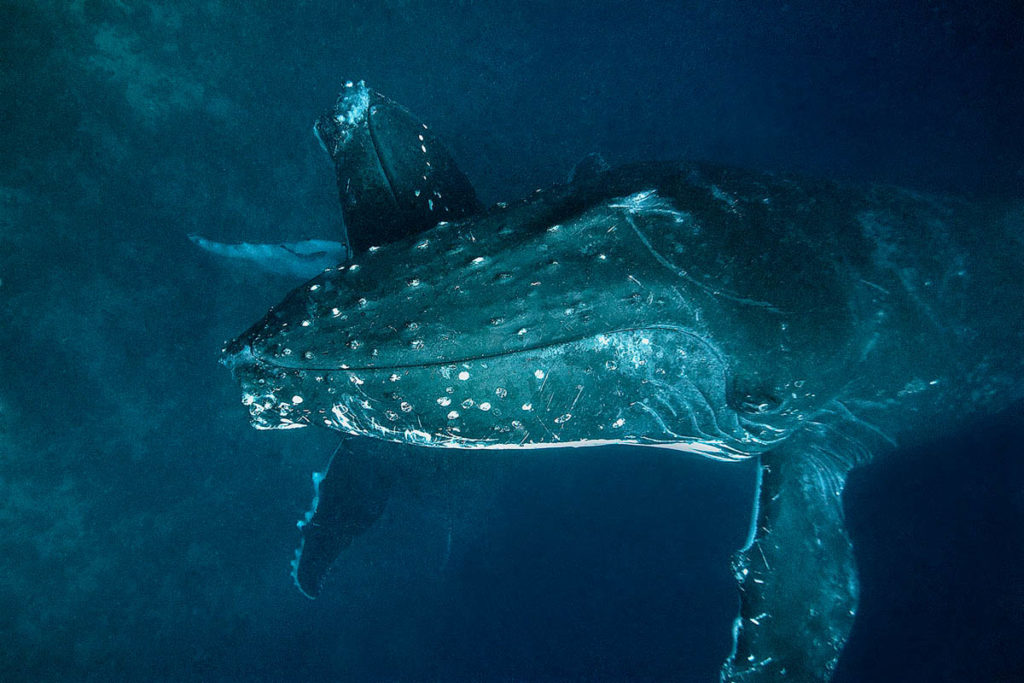
On another day, again a mother-calf-escort is spotted. As we ease the skiffs in for an encounter, the escort appears to become protective, exhibiting a warning display with repeated pectoral and tail-slaps; perhaps the calf is very young, perhaps there is fear we wish it harm. We pause the skiffs and wait. Suddenly, the adult whale rises out of the water in a near-full body breach, perhaps 50 meters away. The sight of this gigantic creature rising, in seeming slow-motion, so close by, is utterly awesome and unworldly – like a four story building suddenly emerging from the sea, only to hang for a moment, then to crash down in a massive spray of water, in all directions.
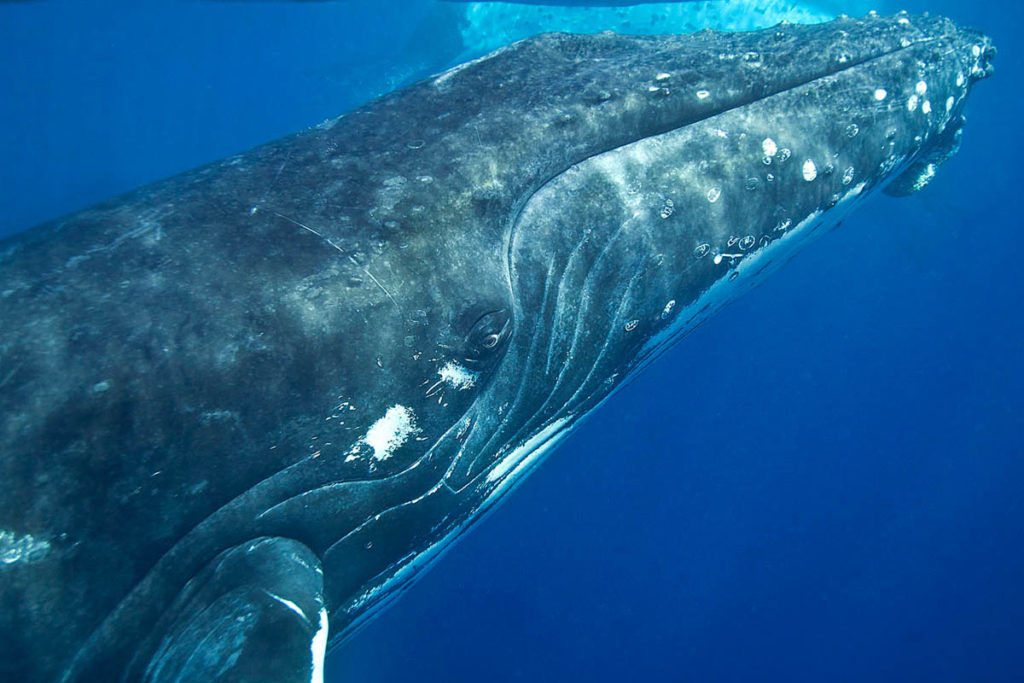
We wait patiently as the whale calms down, with no need to rush, no desire to upset the mother and calf. Finally, we enter the water and slowly approach the threesome resting at the surface. For ten breath-taking minutes, we watch as the calf moves back and forth between us and the adult whales. Eventually, the escort decides we’ve seen enough, and it moves toward us, stopping, blocking our path to – and our view of – the mother and calf. After a short while, it pointedly lets us know we are no longer welcome; it turns onto its side and begins slapping its pectoral fin onto the water in loud, percussive slaps. It is a stunning display; after several minutes of thrilled enjoyment, we climb back into the skiff, happy to give the whales their peace.
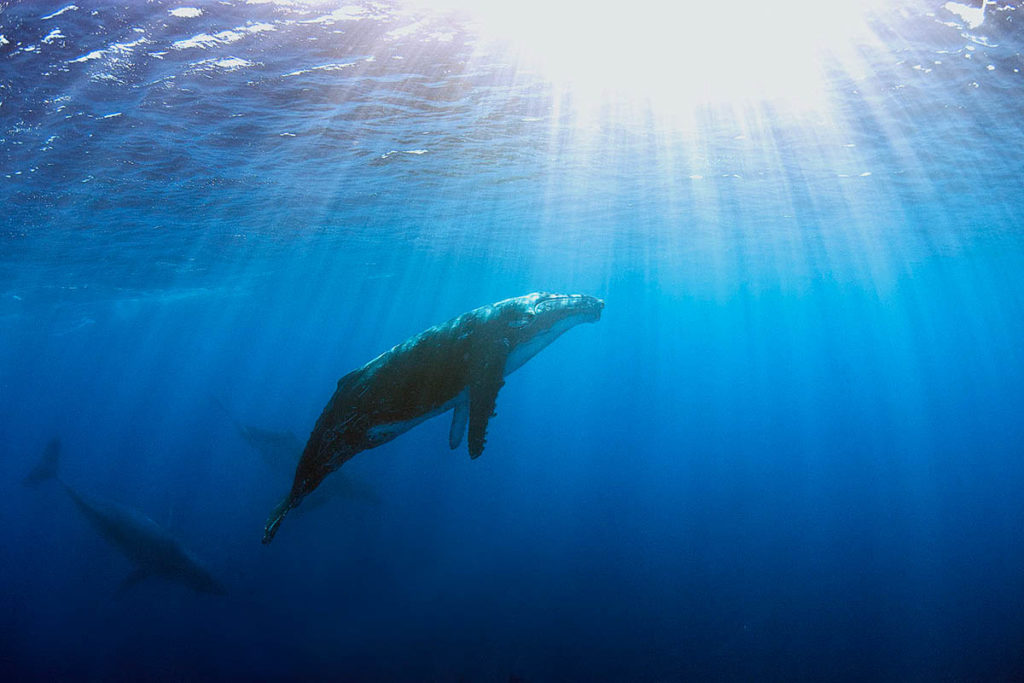
Early one morning later in the cruise, a mother and calf give us a most beatific experience. At sitting down to breakfast, just after dawn, the crew calls out that they have spotted a mother and calf sleeping on the surface, just a few hundred meters away. We jump into the skiffs and slowly approach them. They awaken, but don’t move away. Quietly slipping into the water, I’m afforded a view that, for all the world, looks like a painting, in gigantic scale…clear, blue water, the early morning’s sun’s rays slanting across in soft beams, a mother Humpback Whale resting motionless a few meters below the surface, her calf nestling gently against her side. As I watch, the calf goes to the surface for a quick breath, then comes back down to snuggle against its mama. There is nothing to do but to float motionless; to simply soak in one of the most lovely, ethereal scenes I’ve ever witnessed. (Fortunately, I do also remember to aim my camera and press the shutter periodically.)
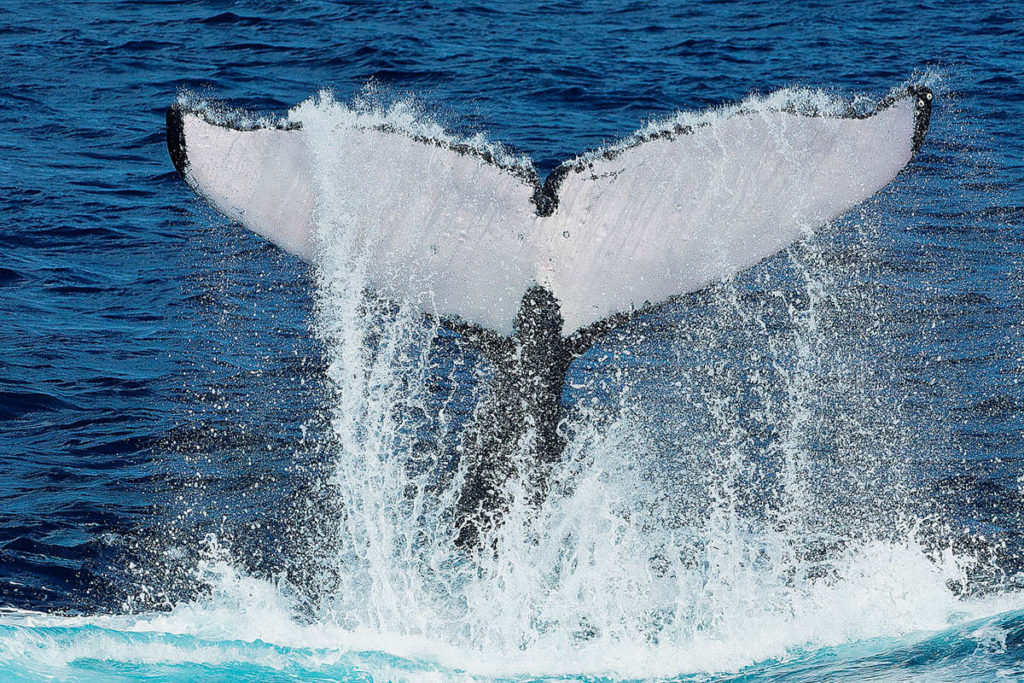
On an afternoon toward the end of our tour, Nai’a approaches another mother and calf on the surface. It seems to be lessons-day for the calf, and we follow along, fascinated, as the mother exhibits a behavior, and the calf repeats it and practices. For nearly two hours, we watch mother breach, swim the back-stroke, spy-hop (standing vertically with the head and eyes out of the water) perform tail and pectoral slaps and more. After each maneuver, it is the calf’s turn, and there are repeated attempts at baby-breaches, baby back-strokes, baby spy-hops and baby slaps. When the calf becomes tired, it swims over to ride on mother’s back for a while, then takes up the lessons once more. Periodically, baby comes over to the side of Nai’a and gives us a look, as if making sure we are watching. (You can bet we were.)
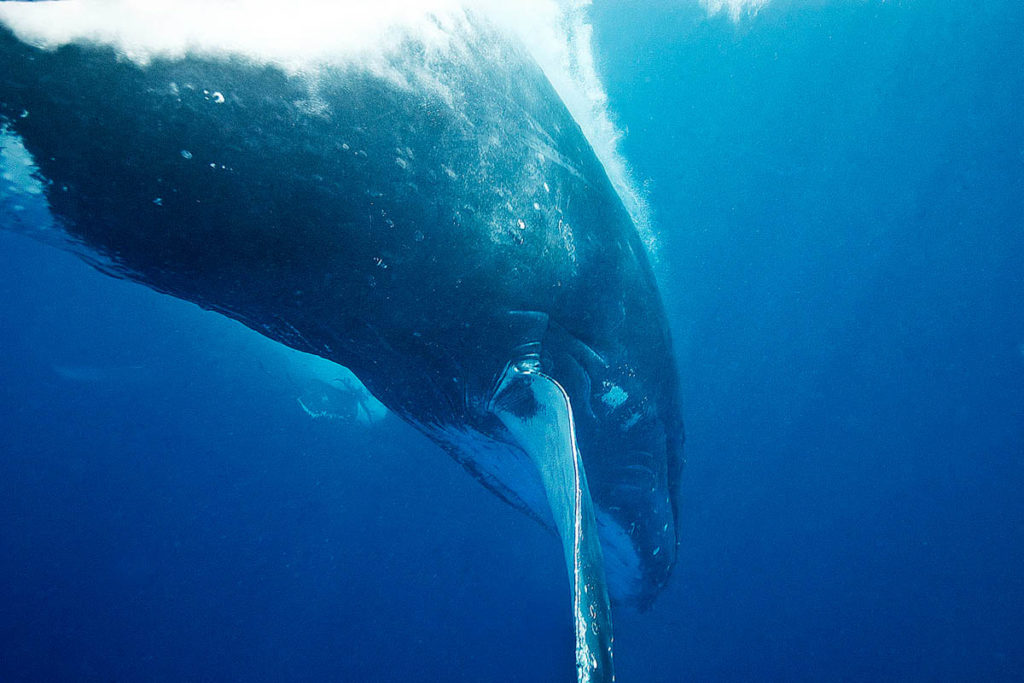
The full, exciting days passed quickly, as they always do on great dive trips, but the experiences we were having in Tonga were numerous, and frankly, astounding. We’d had multiple whale encounters every day, with only two days without an in-water session. Added to this were island visits, interesting reef and night dives, and even a genuine Fijian kava party, complete with singing and guitar-playing late into the night by a talented ship’s crew and a (perhaps less-talented but equally enthusiastic) number of us guests.
But, little did we know that Tonga and its majestic whales were saving their best days for last.
In late afternoon the day before departing for the long trip back to port, we spotted a mother and calf on the surface. I guess because it was nearing the end of our trip, some of the divers became a bit over-eager to record a last, great encounter, and were moving in on the whales too quickly, rather than letting them get used to us, and comfortable, as was the practiced routine. The first two times we entered the water from our skiff, some members of the group moved right in, and the mother simply took her calf quickly out of sight, leaving us with only a distant glimpse, and no images. Being on assignment and needing pictures – and also have learned long-past from my woodsman father that you get the best, closest encounters with wildlife when you let the animals’ natural curiosity bring them to you once they are comfortable – I will admit to having become frustrated.
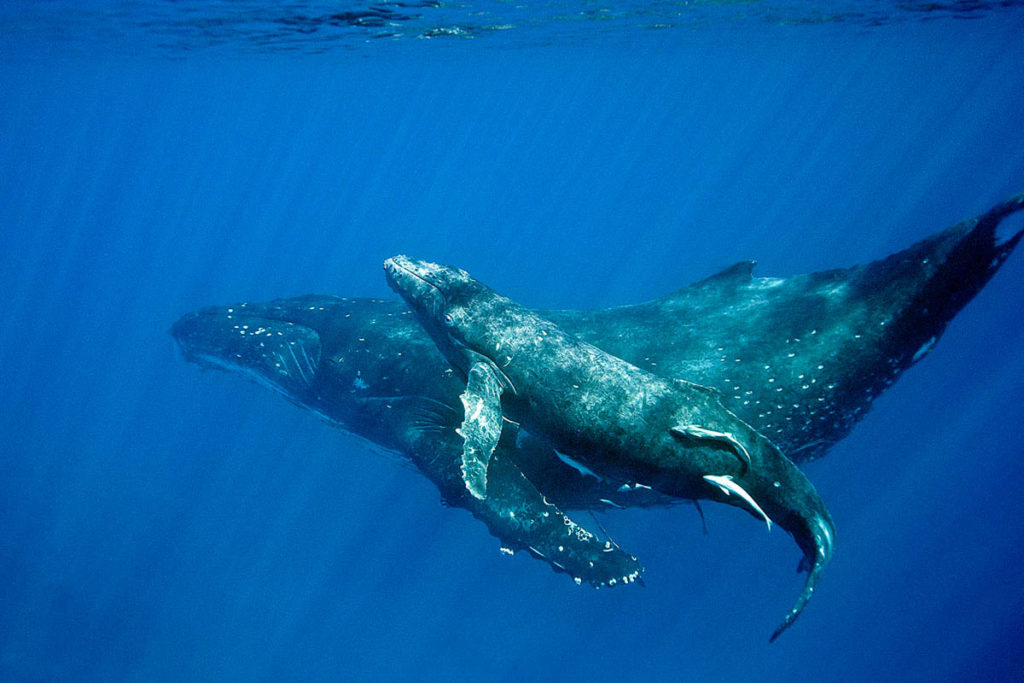
Fortunately, the mother wasn’t taking her calf too far away each time, and we got a last chance. Again to my frustration, as soon as we were close enough to see the whales underwater, the over-eager members of our group began moving too quickly toward them once again. As the mother again began to exhibit signs of restlessness, I separated myself from the other people and swam to the far side, past where the fewest people were, well away from anyone and feeling that the whales would likely turn to avoid the group as they departed, going one direction or the other, perhaps (hopefully?) away from the close group of approaching divers. As I watched, head above the surface, the whales began to swim away from the group, turning…my way. As they approached, I finned down gently and hung motionless at about 7 meters. They continued to come, slowly, until they passed directly over me, the calf so proudly swimming just above his mother’s head. I got several images, one of which has remained as one of my favorite images ever taken, which seems to have named itself, “Flying with Mama…” They then gave me another special image, of the two of them, the calf resting on its mother’s back, as they reached the surface, so very close to me.
The next (and last) day of the trip – the familiar cry of “Whales!” interrupted our packing as we readied to begin our overnight return to port. What appeared to be several whales, with perhaps a mother and calf, had been spotted in the distance. Asked if we would like to try for one final encounter – we had about 45 minutes to spare – several of us jumped at the chance, though the seas were rough, the conditions blustery. As we approached in the skiff, the water became alive with splashing, jostling whales – two males were fighting over a female with her calf in tow.
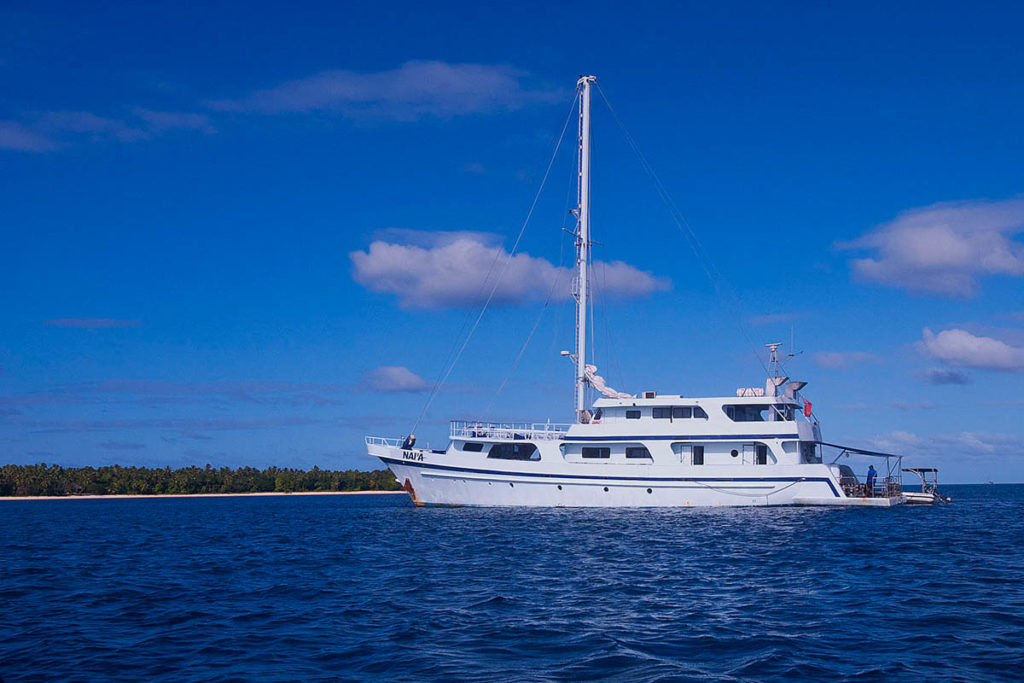
We entered the water and approached the melee cautiously. The small calf – only about 5 meters in length and seemingly disturbed by the aggressive behavior of its mother’s suitors – swam toward us, then moved on past, heading quickly away from the riotous and potentially dangerous situation. As we neared the violent whales to within about 15 meters, one of the males went head-down and began tail-slapping, raising his huge tail high into the air and repeatedly slamming it onto the water, each impact a loud, jarring “Whump!” on the surface. I cautiously edged in – these were adult whales, after all, some 12 meters long – until I was close enough for an underwater view of this incredible display.
For the next 30 minutes, the whales would disappear into the dark water, then suddenly appear again, giving us tantalizing glimpses of the competition for the female’s attentions. At one point, noting a movement well below me – it was often only the flash of a white-edged pectoral fin that caught your attention – I realized that there were only two whales. One suitor had won, and he and the slightly larger female had begun swimming closely together, and quickly passed out of sight in the dim light.
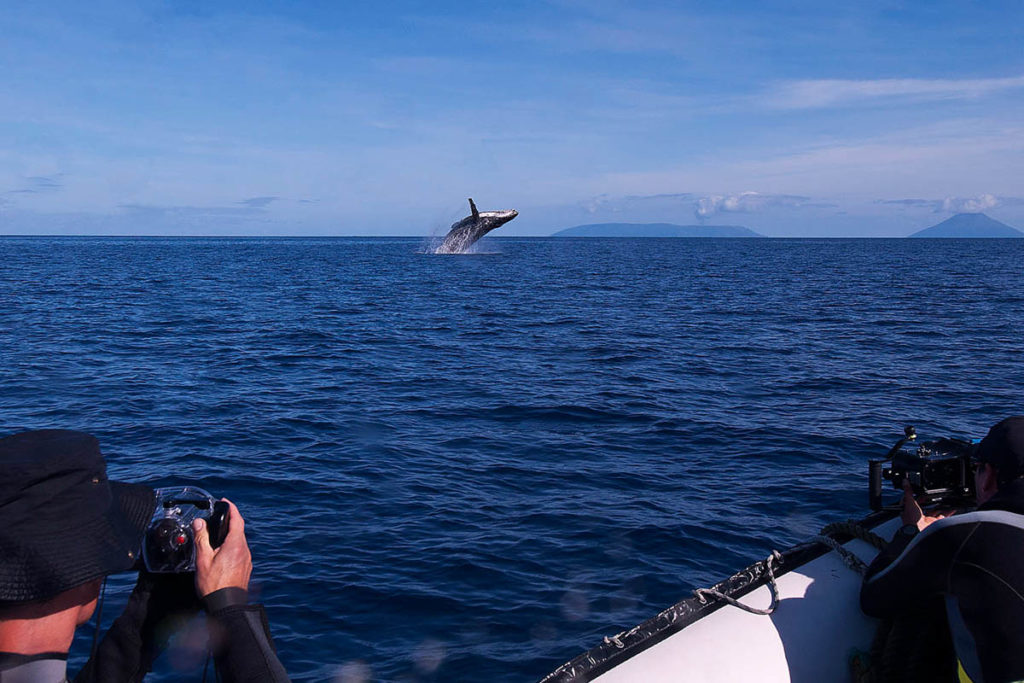
After having not seen the whales for a while, I had begun to accept that the amazing encounter had ended. Then, I noticed vague shapes and movements down deep, in the dark water along the edge of a sheer reef wall. Free-diving to about 15 meters, I found the two whales, suspended closely side-by-side in the water, gently caressing each other – and they didn’t seem to mind being photographed, as I made dive after dive.
As I headed upwards from my 5th or 6th trip, I realized the whales were slowly following. The male ascended from directly below me, and I began to think I was going to end up on his back. To my delight (relief?), at the last moment he turned, the female just beyond him, and gave me an eye to eye look from just a meter away. As he broke the surface, he quickly raised his massive tail to dive – my last, indelible memories of this breathtaking encounter were of foam and bubbles streaming from his rapidly descending body, and his tail turning slightly to avoid me as it came down hard, the wake of the powerful thrust lifting me gently, up and away.
Those days with the Humpback Whales of Tonga were an utterly unique experience. After years of wanting to make this voyage, I had very lofty hopes, but uncertain expectations. The very thought of being in the water, up close, with these huge, beautiful whales – and even possibly their calves – was something that seemed almost beyond imagination. Well, I’ll happily say it again – those hopeful imaginings were nowhere near the incredible reality. Now, that’s truly special.
Al was assisted on this article by the dive vessel, Nai’a. www.naia.com.fj



